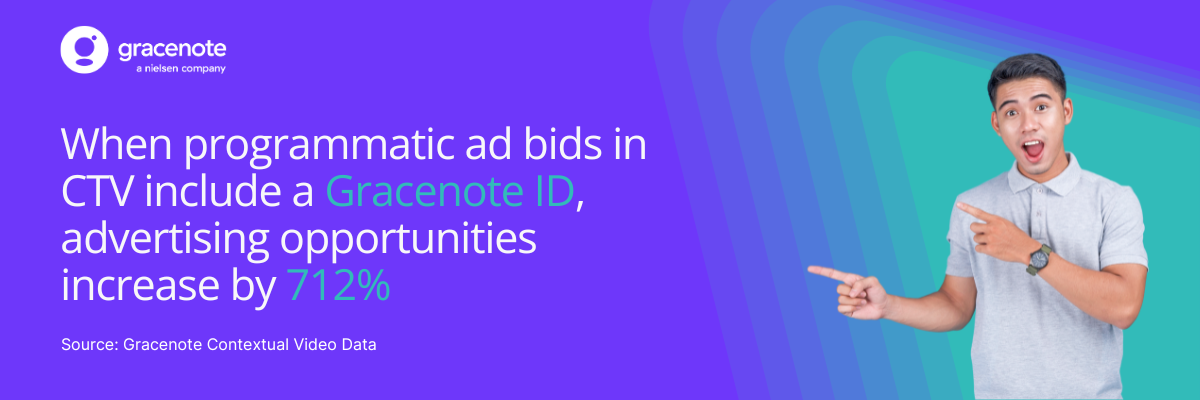With the TV landscape shifting to streaming, there’s no short-selling the appeal of CTV1 advertising. The challenge for marketers, however, is that many are grappling with validating their investments in the space. Much of the challenge tracks back to ad targeting, especially amid rising privacy regulations and cookie deprecation.

The challenges are understandable, especially those tied to programmatic ad buys, which the IAB expects will account for 75% of the anticipated $22.7 billion in CTV ad spending this year. In programmatic ad buying, the ad tech needs to know what it’s bidding on to determine if it wants to make a bid or not. And therein lies the problem. That’s because in most cases, there’s very little information to go on.

In a recent study, Gracenote analyzed more than 6.8 billion publisher-supplied bid requests to understand how much information (e.g., genre, rating, content type) about the video inventory was available. The analysis found that the inventory had an average of just 0.73 biddable categories—attributes that provide some degree of information about the content, such as genre, content rating or program type. Content can have an array of biddable categories, but the average title in this sample didn’t even have 100% of any single one.
The sample bid request data highlights how little information is typically available for real-time decision-making. When it comes to genre, for example, each piece of CTV content has an average of at least 1.6 genres, and more than 50% has two or more.

With little information to base most bids on, it’s not surprising that CTV ranked behind almost all other digital channels in perceived effectiveness among the marketers surveyed for Nielsen’s 2024 Annual Marketing Report. But in today’s media environment, there’s no reason that programmatic ad buys need to be done blindly.
That’s an easy thing to remedy, especially as the industry begins to leverage contextual program data to inform ad buying and selling decisions. When content inventory includes a Gracenote ID, the inventory includes an average of 5.96 biddable categories, increasing the advertising packaging opportunities by 712%.

There is significant upside here. Increased visibility into TV content could shift marketers’ perceived effectiveness of their biggest CTV investments. And for publishers, leveraging contextual data can expand targetable inventories, heighten CTV transparency and drive higher CPMs.
To benefit from the potential, however, more data is needed in programmatic bid requests. This is where publishers can help. Specifically, publishers can lean on data companies to include normalized and scalable program data in their bid requests. By including transactable content IDs that demand-side platforms (DSPs) recognize, advertisers gain much greater insight into the content they’re investing in because the IDs are linked to a wealth of additional content information, such as genre, content rating, content advisories, language, mood and more.
To better understand how visible content attributes are in programmatic ad buying, Gracenote recently analyzed a week’s worth of sell-side platform (SSP) bid requests to identify what percentage of the total volume included content attributes. The data included 21.4 billion bid requests, and only 32% included a genre content attribute. In total, 14.6 billion did not include any genre information. That means advertisers had no meaningful genre visibility into the specifics of almost 70% of the content available for advertising.
The presence of Gracenote IDs in bid requests, however, facilitated much greater transparency into content inventory. For example, 2.4 million of the 2.7 million bid requests that a prominent smart TV manufacturer submitted included Gracenote IDs. On average, these bids included 10 different types of contextual information about the content (referred to here as ‘signals’). These signals can include additional genres, program type, parental rating, language, mood, theme and inclusivity of cast data.
Now, let’s look at a hypothetical bid request scenario for an individual program. The example below showcases two different sets of data that a publisher could make available in an open real-time bidding scenario for a single TV program. The data on the left lacks specificity, includes a spelling error and does not include a content ID. The data on the right has been normalized and enhanced to provide greater specificity and detail. It also includes a Gracenote ID, which means advertisers have access to deeper contextual information, including several genres and a content rating.

The migration of eyeballs to CTV and streaming content presents publishers with an opportunity that many have yet to capitalize on. But by pivoting to strategies that focus on the content, publishers and advertisers alike have an opportunity to drive better outcomes by simply tapping into existing datasets.
With show-level attributes like program type, genre, ratings and parental warnings available, brands can implement better targeting and ensure brand safety, while publishers can maximize revenue on inventory with enhanced program details.
Note
- CTV stands for connected TV and refers to any television that is connected to the internet. The most common use case is to stream video content.
How brands can tap into the growth of live sports on FAST channels
The ongoing addition of live sports to FAST channels is a notable opportunity for brands because of their real-time appeal with sports fans.
How contextual targeting can help marketers reach the scale they need in CTV to build their brands
By tapping into the visibility that contextual signals provide, brands can overcome their top challenges in CTV advertising and find the scale they’re looking for.
2025 Gracenote contextual targeting report
User-based targeting is great for delivering performance, but people don’t watch TV ads the way they watch ads on social media.